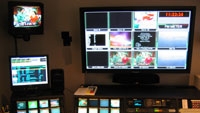Automation providers focus on BXF implementation

Automation Technology Update recently spoke with Rodney Mood, CTO of Crispin, to get his take on the immediate future for broadcast automation.
Automation Technology Update: Are you expecting any changes in broadcast automation this year?
Rodney Mood: We expect there will be a couple of important changes in broadcast automation that will be readily apparent at NAB this year. First, broadcasters will continue to see high-quality automation systems that are more competitively priced. Crispin has been leading this effort with the long-standing tradition of offering a highly modular and highly scalable solution that allows customers to buy only what they need and can expand in the future as their needs grow. We're seeing other automation systems mimic this approach in various ways, too.
We also expect that automation providers will be focusing on the emerging SMPTE S-22 Broadcast Exchange Format (BXF) standard. BXF provides a robust interface mechanism between disparate broadcast systems (e.g. automation and traffic) to exchange mission-critical data. Crispin has been a working member on the SMPTE standards committee and has recently implemented the Crispin BXF Service at WGCU [the PBS affiliate in Fort Myers, FL]. The system is providing a dynamic and automated exchange of the traffic playlist from ProTrack to the Crispin automation system. Although live working systems like this one at WGCU are very rare — given this new standard that is still pending formal approval — we expect customers will have seen and heard much about BXF at NAB from many automation providers.
ATU: Do you see any trends emerging in the design and implementation of automation systems?
RM: Broadcasters continue to demand more from automation systems, especially in the area of providing support for multiple channels and workflow optimization. Crispin has launched the 2007 release of System 2000, which has many new features that allow multiple channels to be controlled from any location. Crispin's new supervisory view provides a high-level view of up to 16 channels of key status indicators and 90-minute timeline views for each channel. It gives operators and engineers a quick way of seeing where attention is needed by summarizing warnings, errors and indicators for all channels in a novel, easy-to-understand user interface.
ATU: Did you expect to see innovations at NAB?
Get the TV Tech Newsletter
The professional video industry's #1 source for news, trends and product and tech information. Sign up below.
RM: As broadcasters continue to move away from analog and tapes, they need new tools and practices to manage their digital assets. Crispin has developed its own fully integrated digital transcoding solution into the Crispin archive and asset management system. With this new feature, a user can copy content from one location to another, regardless of the source video format, and have it automatically transcoded into the proper format when it arrives at the destination. This also future-proofs a station that has digital archives in a specific video format (e.g. Grass Valley MPEG), allowing Crispin to automatically transcode this to any other desired format later when it's restored.
ATU: Do you see the rise of IPTV impacting automation? And what about mobile TV?
RM: TV stations provide value in two distinct ways: value-added distribution and content production (such as local news). Automation should augment each of these two value chains. The new technology of IPTV and mobile TV with handheld devices relies on providing broadcasters the control over distribution in efficient ways and allowing them to reuse their licensed or produced content.
For example, the Crispin NewsCat system — combined with the embedded digital transcoding technology in the Crispin archive and asset management system — allows news organizations to quickly redeploy news stories that were digitally archived in NewsCat into new formats suitable for deployment to the Web or even to mobile phones. We feel this broad and encompassing approach will fit well into the broadcasters' needs with IPTV, mobile TV and other new distribution technologies that are yet to arrive.
